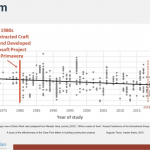Touchplan recently formed a technology partnership with Oculo, a company that uses 360 cameras, state-of-the-art computer vision and artificial intelligence to give a single source of truth for onsite construction progress. We sat down with Founder Tom Kotecki to learn more about the company’s technology and its impact on the construction industry.
Tell us a bit about Oculo and the motivation for starting it?
Oculo is the simplest, fastest way to create a digital copy of your construction site. It’s an entirely comprehensive visual documentation. In terms of the motivation for the company, the original inspiration – look, my background is not from the construction industry, it’s in the tech industry. The original inspiration came from visiting my first big construction project in central London and seeing that back then (2019), a lot of processes were still being done with pen and paper, with pictures shared via WhatsApp or manual production workflows. Being a tech guy, I knew there was a much better way to do this. Then as we got started, we quickly realized that the problem wasn’t that there weren’t any tech tools available, nor was it the common stereotype that the construction industry is technologically backward. In fact, we met many incredibly progressive and tech-savvy people in the industry. The real problem is the tech tools they are offered are just so bad, it wasn’t surprising that they were not using them. Oculo is here to fix this problem. We’re here to provide tools that help people do their jobs, and which are as easy as possible to use and naturally fit into their workflows. So instead of folks having to take manual photos, fill in long forms, and organise them manually – we just allow them to fully passively capture every single square inch of the site, effectively vacuum in all the data from the site, and make it available on a virtual canvas on which you can then unlock a whole bunch of workflows.
What has been the reaction to Oculo from the industry so far?
Really positive! We’ve seen great enthusiasm and growing usage across the board. General contractors, developers, and asset owners are all using it. There is quite a lot of adoption on projects, small and large. We’re already working on some of the most significant projects in Europe, and there have been a lot of benefits our customers have realised.
What is the value that all these users see from Oculo?
Oculo is being used to track progress and align the construction team around the shared version of reality. Oculo eliminates the discussions based on opinions and human memory, and instead presents the facts, allowing everyone on the team to see the same thing. It’s also used to eliminate unnecessary travel and enables remote work, which in COVID times, in particular, was a huge pain point. But even post-pandemic, we are seeing that those new patterns of behavior are here to stay – why wait a week for somebody to arrive and approve a change when it can be done remotely the same day? Also by allowing our users to easily go back in time, we’re giving them perfect recall and making it really easy to assess what happened whenever there is an issue and ultimately, significantly reduce the cost of claims or rework. If there is an issue and you need to rework something, identifying where to do this begins with knowing who did what and when. Being able to narrow down the scope of that work is a huge benefit and cost saver to our customers.
So how is all this reality being captured? Is it folks using cameras on Helmets? Drone footage? A little bit of each?
We use off-the-shelf 360 cameras which are mounted on hard hats – then all you need to do is press the record button and just walk your site. It requires close to zero training; anybody can do it. It’s hands-free and completely passive – there are no QR codes, no beacons to install, no extra buttons to press, nothing else required whatsoever. You just walk the site at your normal speed, and that’s it. We take care of the rest and map it all for you automatically.
What was the motivation for partnering with Touchplan?
Our companies clearly share the same vision. We’re both interested in providing best-of-breed, customer-centric tools for construction teams and enabling them to work in a transparent and collaborative fashion. That’s the common thread here. Our part is bringing the reality on the ground and making it accessible to everybody on site, and together with Touchplan, we can jointly allow people to plan their work that much more effectively.
So within the users like GC’s or Developers, is there one super heavy user?
Honestly, it’s an ever-expanding set. It starts with the project manager or a project director, for whom initially it’s about having this digital backup, which is available should anything go wrong. The PM starts using it, but then so does the person who captures the data, and soon the rest of the site team. Then there’s value for health and safety people and quality control people who want to ensure work can be done more effectively. We’ve seen meetings with 30 plus people, all dialing in remotely, and all looking at the same reality to review and plan their work. So it goes pretty wide.
So what does life look like five years down the road for Oculo?
There are so many teams within a construction project that can benefit from our technology, and there are so many more workflows that we could enable – we’re just getting started. You can think of Oculo as a virtual canvas on which you can build a lot of those different workflows. We allow our users to capture and organise a wealth of information in 3D, and then if you consider the long-term value of this, there’s lots more to it still. Ultimately, we are passively backing up your entire construction site with a full history of who did what and when, all the asset information, and all the documentation in a single place.
Where can people go to learn more about Oculo?
All you need to do is go to https://oculo.ai or reach out to us directly. Getting started is really simple – all you need is an off-the-shelf 360 camera, which you can buy off Amazon. There’s very little training required, and then off you go! Then as far as the output is concerned, it’s a web tool which means you can access it from any device, anywhere in the world. The tech is inherently accessible and that’s at the very core of our ethos.










